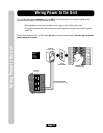
Page 28
FCC and DOC Requirements
FCC and DOC Requirements
FCC Requirements
The units comply with Part 68 of the FCC Rules. The label affixed to this equipment contains, among other
information, the FCC Registration Number and Ringer Equivalence Number (REN) for this equipment. You must,
upon request, provide this information to your telephone company.
The REN is useful to determine the quantity of devices you may connect to your telephone line and still have all of
those devices ring when your telephone number is called. In most, but not all areas, the sum of the RENs of all
devices connected to one line should not exceed five (5.0). To be certain of the number of devices you may
connect to your line, as determined by the REN, you should contact your local telephone company. They will tell
you what the maximum REN is for your calling area.
The following jacks must be ordered from the telephone company in order to interconnect this equipment with the
public communication network: None.
If your unit causes harm to the telephone network, the Telephone Company may discontinue your service
temporarily. If possible, they will notify you in advance. If advance notice is not practical, you will be notified as
soon as possible. You will be informed of your right to file a complaint with the FCC.
Your Telephone Company may make changes in its facilities, equipment, operations or procedures that could affect
the proper functioning of your equipment. If they do you will be notified, in advance, to give you an opportunity to
maintain uninterrupted telephone service.
Connections to party lines are subject to state tariffs. Contact your local telephone company if you plan to use this
equipment on party lines.
This equipment cannot be used on public coin service lines provided by the telephone company.
DOC Requirements
Notice: The Canadian Department of Communications label identifies certified equipment. This certification means
that the equipment meets certain telecommunications network protective, operational, and safety requirements. The
Department does not guarantee the equipment will operate to the user’s satisfaction.
Before installing this equipment, users should ensure that it is permissible to be connected to the facilities of the
local Telecommunications Company. The equipment must also be installed using an acceptable method of
connection. In some cases, the company’s inside wiring associated with single line individual service may be
extended by means of a certified connector assemble (telephone extension cord). The customer should be aware
that compliance with the above conditions may not prevent degradation of service in some situations.
Repairs to certified equipment should be made by an authorized Canadian maintenance facility designated by the
supplier. Any repairs or alterations made by the user to this equipment, or equipment malfunctions, may give the
telecommunications company cause to request the user to disconnect the equipment.
Users should ensure for their own protection that the electrical ground connections of the power utility, telephone
lines, and internal metallic water pipe unit, if present, are connected together. This precaution may be particularly
important in rural areas.
Caution: Users should not attempt to make such connections themselves, but should contact the appropriate
electric inspection authority, or electrician, as appropriate.
The Load Number (LN) assigned to each terminal device denotes the percentage of the total load to be connected
to a telephone loop, which is used by the device, to prevent overloading. The termination on a loop may consist of
any combination of devices subject only to the requirement that the total of the Load Numbers of all the devices
does not exceed 100. The Load Number for EL Series Units is 3.


















